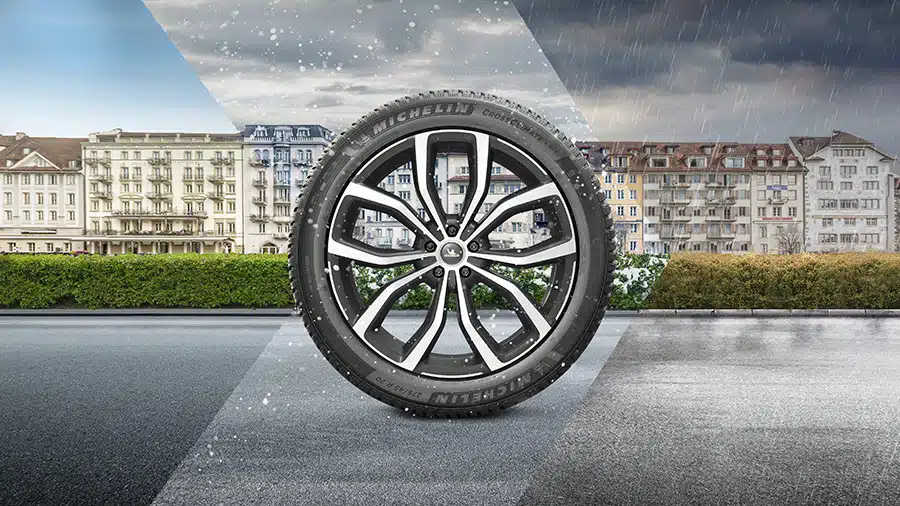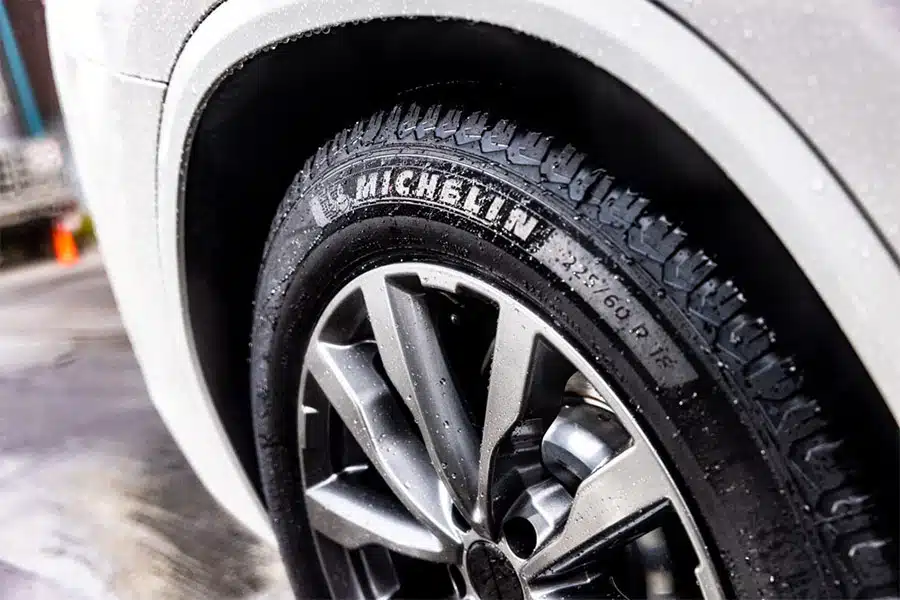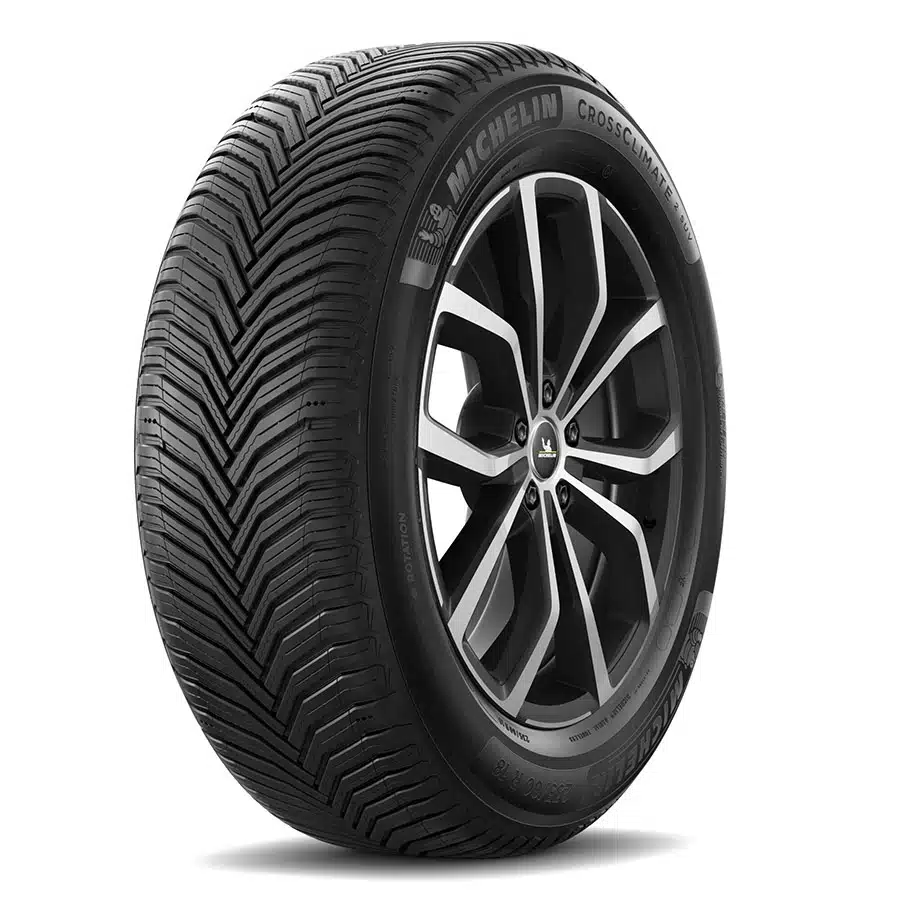“This post contains affiliate links, and I will be compensated if you make a purchase after clicking on my links.”
Pros
-
Exceptional grip and handling balance on dry roads (for an all-season tire)
-
Quick steering with a natural feel
-
Best-in-class braking in rainy conditions
-
Strong overall performance on wet tarmac
-
Outstanding snow traction and drivability for an all-season tire
-
Supremely quiet, even on coarse roads
-
Good ride over broken pavement
Cons
-
Shorter treadwear warranty than its direct competitors
-
Slightly firmer than its rivals on smooth roads
Michelin struck gold ever since it launched the first-gen CrossClimate grand-touring all-season tire. Thanks to the innovative tread pattern, Michelin’s advanced all-season tire combined excellent dry and wet performance with class-leading light-snow traction.
However, it wasn’t without its faults – the original CrossClimate wasn’t as good at dry/wet braking as its premium rivals, and the treadwear warranty was lower. Not wanting to lag behind, Michelin quickly launched the improved CrossClimate 2, which comes in regular sizes for sedans, hatchbacks, and SUV/crossover dimensions.
In this review, I’ll cover the SUV version of the CrossClimate 2. For the regular grand-touring all-season model, check my other review here. Both tires are broadly similar, but there are still some slight differences in the tread pattern, with the regular CrossClimate 2 having fewer zig-zag sipes on the inner sides of the tread blocks.
With that said, the CrossClimate 2 SUV is quite an expensive tire, despite having a not-so-stellar treadwear warranty. Michelin is still the most trusted tiremaker globally, but has the French giant delivered with the CrossClimate 2 SUV? And, more importantly, should you splurge the cash and buy a set? Let’s discuss!
What are the features of the Michelin CrossClimate 2 SUV?
The CrossClimate 2 SUV utilizes Michelin’s Thermal Adaptive all-season compound, molded into a V-type directional tread pattern, similar to a performance tire. The compound is an upgrade over the competitors, providing even better performance at higher and lower temperatures.
As a result, Michelin says the CrossClimate 2 SUV brings the benefits of a summer tire in hotter climates and a winter tire in very low temperatures. These are bold claims, but if anyone could achieve them, it’s Michelin.

As for the tread pattern, the tire retains the unique V-shaped design, which differs from its competitors. The tread blocks align with fore and aft forces, increasing the uninterrupted block area. With this design, Michelin effectively nullified the need for a continuous center rib, which gives other tires cornering stability. And since the blocks are larger, they are stiffer overall than the competition, further enhancing stability and steering response.
But there is more to the directional tread pattern. For instance, the V Ramp chamfers molded into the leading and trailing edges of the blocks increase the contact patch under heavy load, much like a performance tire. In addition, the shoulder blocks align laterally with the rest of the tread, which brings even higher G-forces into play. Not to forget, Michelin borrowed the 3D SipeLock Technology from its other tires, stabilizing the tread under load or hard cornering.
And we still didn’t even touch CrossClimate 2 SUV’s water-channeling qualities. Thanks to the V-shaped tread pattern, this tire cancels the need for circumferential grooves to dissipate water from the tread, as the steep angles of the tread blocks can do that very effectively. Thanks to this design, the tire is very good at resisting hydroplaning.

Okay, but what about snow? Interestingly, the CrossClimate 2 SUV doesn’t have as many zig-zag sipes as many of its 3PMSF (Three-Peak Mountain Snowflake) tires have. Instead, Michelin’s all-season tire combines all of the features above to increase snow traction effectively. Namely, although it doesn’t have zig-zag sipes, the CrossClimate 2 SUV has sipes that run across the long blocks, which along with the pliable rubber, provides it with the necessary snow traction.
And if that wasn’t enough, Michelin utilized its PIANO Noise Reduction Tuning tech, which uses advanced computer-aided tread modeling to minimize unwanted noise. Finally, though innovative on the outside, the CrossClimate 2 SUV is a regular touring tire underneath, with a two-ply polyester casing supporting twin steel belts aided by a polyamide reinforcement for increased high-speed stability.
What are the Michelin CrossClimate 2 SUV’s maintenance indicators?
Michelin didn’t support its groundbreaking maintenance indicators like its biggest rival, Continental, and instead gave the CrossClimate 2 SUV the industry-standard wear indicators.
The French giant used them to connect the tread blocks and stabilize the tread; however, they can only show you when the tread depth reaches 2/32 inches, which is the lowest legal value in most countries globally.
The reasoning is that tires with less than 2/32 inches of tread depth won’t have the hydroplaning resistance qualities it needs for a safe drive. Unfortunately, the wear indicators can’t show you when the tire reaches 5/32 inches of tread depth, which is considered the lowest safe value for driving in wintry conditions.
What is the Michelin CrossClimate 2 SUV warranty?
The Michelin CrossClimate 2 SUV comes with a 60,000-mile treadwear warranty, which is only average for an all-season touring crossover/SUV tire and below average for a premium tire.

Notably, the Bridgestone Alenza AS Ultra comes with an 80,000-mile treadwear warranty, while the Continental CrossContact LX25 and Pirelli Scorpion AS Plus 3 come with a 70,000-mile warranty. Even the cheaper Cooper Discoverer SRX comes with a 70,000-mile warranty, and other budget-friendly tires usually have 65,000-mile treadwear warranties.
But the thing with Michelin tires is that they usually exceed expectations regarding treadlife. In addition, tires from the French manufacturer keep the excellent performance they offer throughout their lifetime, including wet and snowy surfaces. So, although it’s nice to have a higher warranty at this price, I wouldn’t make a big deal out of it. Still, the Bridgestone Alenza AS Ultra is an excellent alternative if it bothers you.
How does the Michelin CrossClimate 2 SUV behave on dry roads?
The CrossClimate 2 SUV provides precise and responsive steering and reasonably high levels of grip for a crossover/SUV touring all-season tire.
Although not aimed at enthusiast drivers, the CrossClimate 2 SUV is still a tire that can give you fun on a twisty road. The steering is very quick and precise, almost on the level of a performance tire. It also provides a good feeling for the road, meaning you’ll always know what the tires are doing.

Despite being very responsive, the CrossClimate 2 SUV is never twitchy. On the opposite, it is very linear, and both axles have enough grip to keep you planted in the corners. Thus, it’s an easy tire to play with and drive fast, qualities that aren’t quite common in the category.
In addition, the overall traction is excellent for a touring all-season tire. The stopping distances are among the shortest in its class, and the lateral grip is exceptional. The CrossClimate 2 SUV resembles a summer tire on dry tarmac, which is high praise, indeed.
Finally, the straight-line tracking is excellent, and the highway stability is exceptional, making the CrossClimate 2 SUV one of the best touring all-season tires in dry conditions.
How is the Michelin CrossClimate 2 SUV on wet and slippery roads?
The Michelin CrossClimate 2 SUV is a very safe tire in rainy conditions, with outstanding longitudinal and lateral grip and easy-to-control nature at the limit.
Thanks to its innovative directional tread pattern, the CrossClimate 2 SUV has by far the best longitudinal traction in its category. In other words, it provides the shortest stopping distances of any other crossover/SUV all-season touring tire, along with the best acceleration.

But it’s not only acceleration and braking where the CrossClimate 2 SUV excels. The lateral grip is also among the best you’ll get in the category, giving you the freedom to drive faster in the rain without worrying about losing stability.
The best thing about Michelin’s model is that it behaves naturally at the limit. Namely, when the tires lose traction, your crossover/SUV will understeer over all four tires, making it easy to correct by backing up a bit. This is in contrast to cheap tires, which can be unpredictable at the limit.
It also helps that the CrossClimate 2 SUV has responsive and natural steering, a quality that few other models match, especially in the rain.
Furthermore, this tire excels in heavy rain, where the directional tread pattern works its magic and limits hydroplaning, even at very high speeds. As a result, your vehicle will remain stable when you drive on the highway and hit a large puddle of water.
With that being said, how is the Michelin CrossClimate 2 SUV on snowy roads?
The Michelin CrossClimate 2 SUV is one of the best touring all-season tires on snow-covered roads, with excellent overall traction and surefooted handling.
When I first tried the predecessor, it caught me off-guard how good it was on snow. It was genuinely possible to drive faster on snow with the original CrossClimate – there was loads of traction, and the steering/handling was very accurate.

This time, I knew what to expect, but the CrossClimate 2 SUV still impressed me. Although the competition from Continental, Bridgestone, and Pirelli has caught up, the CrossClimate 2 SUV remains one of the best all-season tires in winter weather, period.
Longitudinal traction – acceleration and braking for those not following the tire space – is better than any competitor out there. This means even deeper snow won’t leave you stranded, and you’ll have enough time to brake and avoid an accident.
But the superlatives don’t stop there – the CrossClimate 2 SUV is also great in the corners. The front tires grip well and provide a responsive turn-in, and the rears follow suit. Overall, the handling is very balanced and easy to control at the limit, which is a big plus.

With all that said, I must put a disclaimer here – although the CrossClimate 2 SUV is impressive on snow for its category, it still won’t replace proper winter tires in very harsh conditions. The biggest issue is icy roads, where the CrossClimate 2 SUV performs much worse than a winter tire, but there are also significant differences in deeper snow.
Thus, a proper winter tire is still the best option if you live in harsh, wintry conditions. However, the CrossClimate 2 will do just fine for most people while giving you excellent performance in all other seasons.
Is the Michelin CrossClimate 2 SUV suitable for off-road driving?
Although the CrossClimate 2 SUV is designed to fit modern crossovers and SUVs, it’s not an off-road tire and won’t provide sufficient traction. Moreover, it doesn’t have special reinforcements, and sharp rocks could easily damage it.
If you are into off-roading or overlanding, I highly recommend going for all-terrain or maximum traction off-road tires exist. These tire categories have much more aggressive tread patterns for added traction and reinforced materials that resist cuts, chips, and punctures.

Is the Michelin CrossClimate 2 SUV a run-flat tire?
The CrossClimate 2 SUV is not a run-flat tire, so if you have a puncture, you should either replace it with a spare or use a tire sealant. However, you can find the CrossClimate 2 ZP (Zero Pressure) in some markets, which is a run-flat tire.
If you live in North America, though, you can find other Michelin run-flat tires – just look for “ZP” (Zero Pressure) in the name.
How are the Michelin CrossClimate 2 SUV’s road noise and comfort performance?
The CrossClimate 2 SUV is one of the quietest crossover/SUV touring all-season tires on the market and has a solid ride quality.
There is really not much to talk about regarding the sound quality of Michelin’s latest all-season model. There is almost no tread noise entering the cabin at lower speeds, and the wind usually overpowers it at higher speeds. The CrossClimate 2 SUV is even quiet on a rough tarmac, where most of its competitors would produce a disturbing noise.

As for the ride, it’s a tad firmer than the competition, especially for a touring tire. Still, while this means more minor road imperfections will enter the cabin as vibrations, it also means that the CrossClimate 2 SUV handles larger and sharper bumps better.
Doesn’t sound logical? Let me clarify that for you; softer tires generate a secondary movement when they hit a bump, i.e., they need more time to settle down, which makes the ride on cracked asphalt less refined. Meanwhile, stiffer tires settle down more quickly, making the ride more refined. Of course, what I said is not a rule, and many tires prove otherwise. Still, in this case, that’s true.
So, on the whole, the CrossClimate 2 SUV is a tire that few will find at fault comfort-wise.
Should I buy the Michelin CrossClimate 2 SUV?
If you have a deep-enough budget and want a tire that will work in all seasons, you should definitely put the Michelin CrossClimate 2 SUV on your shortlist. It’s a premium tire with almost no disadvantages to speak of and one that excels on dry, wet, and snow-covered roads.

Still, you might also want to look at its main competitors. For instance, the Bridgestone Alenza AS Ultra provides similar dry/wet performance yet offers a superior 80,000-mile treadwear warranty. At the same time, the Continental CrossContact LX25 comes with a 70,000-mile warranty and is comparable to the CrossClimate 2 SUV in dry, wet, and snowy conditions.
If your budget is more limited, the Yokohama Geolandar X-CV is an excellent touring tire with a strong performance in dry and wet conditions, while the Cooper Endeavor Plus offers a 65,000-mile warranty at a very competitive price point.
What sizes does the Michelin CrossClimate 2 SUV come in?
For this generation, Michelin merged the CrossClimate 2 with the SUV/crossover variant. As a whole, the model is available in unprecedented 89 different sizes, ranging from 16-inch to 21-inch wheel diameter. However, other markets, like Europe, get the CrossClimate 2 SUV model, which is available in 43 sizes, ranging from 17-inch to 20-inch wheel diameters.


Your review is spot on.
I am on my 2nd set of the cross climate 2 tires and they get easily 15000 to 25000 more miles than the warranty. I always see them get a slightly lower rating on dry pavement but I can assure you they will have no problem stopping. The difference is it is a much smoother stop. I am a pet transporter and I drive in all kinds of adverse weather. A typical trip can take me from heavy Florida rain from South Florida for days as I travel into extreme high temps in Texas of 115 degrees to mountain terrains in Pennsylvania’s with gravel roads that hold ice and to minus 15 degrees In Vermont all in less than a week. I travel mostly in the eastern half of the United States but have also traveled to the northwest many times with my Cross Climate 2 tires. I tried another brand recently ( Yokohama Tornante ) but ended up taking them off at 500 miles in less than a week. I am considered an extreme driver and mostly drive highway but many times I can be on dirt roads with soft sand and ruts or a foot deep of snow going straight up a hill from a dead stop. My tires don’t slide or get stuck. I easily drive over 10000 to 15000 miles per month.
I would love to be sponsored by Michelin if you could help me out in that or I would even love to be a tire tester for them
I help many people and rescues
get their pets home safe.
I go through two complete sets of tires per year. 235/ 60/r17.
*****Anyone considering these tires I can promise you that you will not be disappointed. I have found it takes about 500 miles for any tire to get broke in well so I always wait to make my decision on a tire until that time. But I traveled over 80,000 miles on my last set of Cross Climate 2 tires so I am speaking from experience. So before someone mentions about Michelin tires sound I can tell you that it is only on concrete roads not asphalt but any tire will do that and it is minor. I think that is a safety feature because most concrete roads seem to be slick and the sound reminds you to be careful. Most people don’t realize that a new tire has slightly less traction then one that is slightly worn. So I always give it the 500 mile test. Also I have found since I drive a 2018 Toyota Sienna XLE fwd van that they tend to sway in the rear some even with the new shocks and struts I replaced. The cross climate 2 tires help significantly with that and they don’t have what I call that silicon drift feel that I find in many other tires have on a curve. I have vertigo and I am very sensitive to the change in feel. I Always feel very secure with the Cross Climate 2 tires on and if you try these tires you will never want a different one on your vehicle ever again.
I wonder how this tread pattern works in the snow, while going up a semi steep driveway backwards?